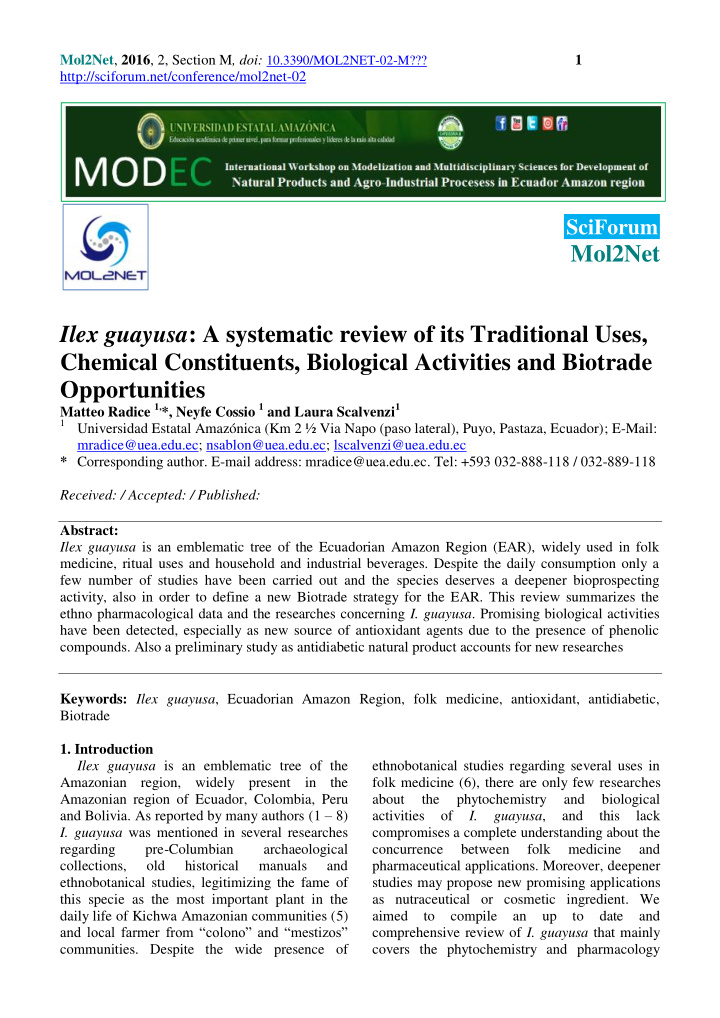



Mol2Net , 2016 , 2, Section M , doi: 10.3390/MOL2NET-02-M??? 1 http://sciforum.net/conference/mol2net-02 SciForum Mol2Net Ilex guayusa : A systematic review of its Traditional Uses, Chemical Constituents, Biological Activities and Biotrade Opportunities Matteo Radice 1, *, Neyfe Cossio 1 and Laura Scalvenzi 1 1 Universidad Estatal Amazónica (Km 2 ½ Via Napo (paso lateral), Puyo, Pastaza, Ecuador); E-Mail: mradice@uea.edu.ec; nsablon@uea.edu.ec; lscalvenzi@uea.edu.ec * Corresponding author. E-mail address: mradice@uea.edu.ec. Tel: +593 032-888-118 / 032-889-118 Received: / Accepted: / Published: Abstract: Ilex guayusa is an emblematic tree of the Ecuadorian Amazon Region (EAR), widely used in folk medicine, ritual uses and household and industrial beverages. Despite the daily consumption only a few number of studies have been carried out and the species deserves a deepener bioprospecting activity, also in order to define a new Biotrade strategy for the EAR. This review summarizes the ethno pharmacological data and the researches concerning I. guayusa . Promising biological activities have been detected, especially as new source of antioxidant agents due to the presence of phenolic compounds. Also a preliminary study as antidiabetic natural product accounts for new researches Keywords: Ilex guayusa , Ecuadorian Amazon Region, folk medicine, antioxidant, antidiabetic, Biotrade 1. Introduction Ilex guayusa is an emblematic tree of the ethnobotanical studies regarding several uses in Amazonian region, widely present in the folk medicine (6), there are only few researches Amazonian region of Ecuador, Colombia, Peru about the phytochemistry and biological and Bolivia. As reported by many authors (1 – 8) I. guayusa , activities of and this lack I. guayusa was mentioned in several researches compromises a complete understanding about the regarding pre-Columbian archaeological concurrence between folk medicine and collections, old historical manuals and pharmaceutical applications. Moreover, deepener ethnobotanical studies, legitimizing the fame of studies may propose new promising applications this specie as the most important plant in the as nutraceutical or cosmetic ingredient. We daily life of Kichwa Amazonian communities (5) aimed to compile an up to date and and local farmer from “colono” and “mestizos” comprehensive review of I. guayusa that mainly communities. Despite the wide presence of covers the phytochemistry and pharmacology
Mol2Net , 2016 , 2, Section M , doi: 10.3390/MOL2NET-02-M??? 2 http://sciforum.net/conference/mol2net-02 information, in order to suggest new researches 2.2 Phytochemistry and to offer a complementary paper to the Leaves contain caffeine, theobromine, phenolic ethnobotanical research. compounds and flavonoids as the main components (10-13). Also guanidine was 2. Results and Discussion mentioned as an important component of I. 2.1 Botanical description, historical guayusa leaves extracts (14,15). Another information and folk medicine research performed by Ruiz and Roque (16), Ilex guayusa is an evergreen tree belonging to mentioned a phytochemical preliminary assay on Aquifoliaceae family, native to the Amazon. The ethanolic, methanolic and hydroalcoholic extracts of I. guayusa , the study revealed the plant is dioecious and reaches between 6 to 10 meters tall. The leaves are simple, pinnate, presence of tannins, alkaloids, flavonoids, glabrous, oblong, elliptic with serrate margin; glycosides, phenolic compounds and quinones. they are 7-20 cm long and 2.5-7 cm wide (4). I. A study performed by liquid chromatography guayusa is distributed from 200 to 2000 m above with tandem mass spectrometry (17) of a I. guayusa leaves extract detected several amino sea level along the Andes and contiguous Amazonian piedmont (8). Historical information acids (Table 2), which provide an interesting about I. guayusa was mentioned by Schultes (9). information about nutraceutical profile and taste. From the same author (18), another research on I. Describing an archeological finding from a guayusa leaves extracts, using gas and liquid shaman excavated tomb in Bolivia (Tihuanacoid culture), the author described the presence of chromatography and mass spectrometry, revealed dried and pressed leaves, a mortar and pestle. the presence of two pentacyclic triterpenoid, The finding probably describes the use of the oleanolic (1,18 mg/g) and ursolic acid (18,22 species as snuff during ritual activities and it is mg/g) respectively. feasible that the species has been used for at least 2.3 Biological activity 1,500 years. Since the XVI century until today, Stimulant and protective effect of caffeine and many authors described folk medicine and theobromine are extremely reported in literature commercial activities related to I. guayusa . Even (19-23). As reported by Jara et al . (13), dried leaves of I. guayusa were extracted with ethanol for Jesuit missionary in Ecuador the species was an important source of income (1,3) and, (EtOH) and ethyl acetate (EtOAc). The total currently, a few companies from the EAR are phenolic content was determined selling beverages and infusions obtained from I. Folin – spectrophotometrically according to guayusa . Ciocalteu’s phenol method and calculated as Regarding the folk medicine information, the gallic acid equivalent (GAE). The total Table 1 summarized several traditional uses flavonoids content (TFC) was determined which include ritual and magical application. spectrophotometrically, the antioxidant activity According to the “cosmovisión” concept of the was determined using free radical DPPH (2,2- Amazonian ethnic groups, I. guayusa can be used diphenyl-1-picrylhydryzyl) scavenging method and the β -Carotene bleaching. Results are for multiple porpoises, from human health remedy to the custom of cleansing the stomach reported in Table 3. daily as a ritual purification. I. guayusa tea is Anyway, the presence of phenolic compounds considered a “magical drink” and is also given to and flavonoids may indicate a protection against the hunting dogs, before a hunting expedition, in cellular damage induced by free radical oxidative order to improve their abilities and skills. For injury or reactive oxygen species. These indigenous people, the infusion can also antioxidant properties are associated with the provokes a soft hypnotic effect in which “little presence of phenolic compounds and flavonoids. dreams” can inspire or dissuade in advance a Although guanidine was reported but wasn’t hunting expedition (1). quantified, its presence explains the preliminary hypoglycemic effect of I. guayusa leaves extracts in animal model. Guayusa may reduce hyperglycemia without affect the parameter of glucose homeostasis in non-diabetic mice (14).
Recommend
More recommend